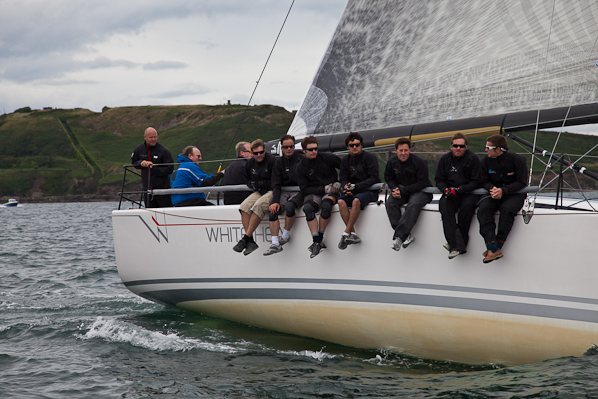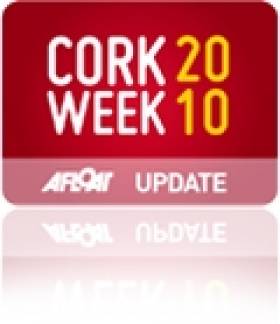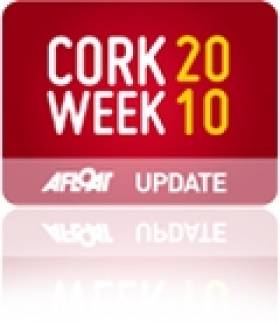Displaying items by tag: Royal Cork
Day Two: Cork Week Offers Light Winds, Mist and Dolphins
A fickle breeze fluctuating between six and eight knots swept in an early morning mist at Crosshaven this morning for the second day of Cork week regatta. Curious dolphins were a regular sight on the race course popping up next to racing yachts, adding to the ghostly sailing atmosphere.
The breeze was from the southeast but barely rose above ten knots. Starts are always important but especially in light wind. Getting into clear air and not stalling the boat was paramount today writes Louay Habib. Photos by Bob Bateman.

Picking up pace. Johnny Vincent's entry is in a commanding position after winning both races today. More Pace photos on the gallery here. Photo: Bob Bateman
IRC Super Zero
Johnny Vincent's Pace continues to impress, winning both of today's races by a comfortable margin. Tactician Jeremy Robinson has won the Rolex Fastnet Race, Rolex Sydney Hobart and is a former 505 World Champion.
"After a couple of minor errors early on, we sailed well today. It was a good team effort and we got off the line really well which is always important. I do enjoy coming to Cork Week. It has a very different atmosphere to some of the regattas that I compete in and there has always been a lot of laughs in Crosshaven." Commented Robinson, after racing.
Pace is out in front after four races, Gray, Laidlaw's Farr 52, Bob, jumps up to second after a great day out. Stephane Neve's French TP52, Paprec Recyclage, drops to third spot.

King maker: Nemo of Cowes is leading IRC Zero class. More Nemo of Cowes photos on the gallery here. Photo: Bob Bateman
IRC Zero
Bernard Lambilliotte's Swan 45, Nemo of Cowes continued their impressive form, stretching out their lead in a class containing some red hot boats, bound for next month's Rolex Commodores' Cup.
"We are delighted with our results, so far." Commented main sheet trimmer Sam Richmond. "Getting into clear air has been pretty much vital. The boats behind us on the water have been mixing it up, slowing each other down a bit. We have a great crew on board but so have the other boats and we are taking nothing for granted."
Nemo of Cowes are now nine points clear at the top. Dave Dwyer's Marinerscove.ie had a much better day and is now second with Bernard Gouy's Ker 39, Inis Mor, helmed by the yacht's designer Jason Ker, moving up to third.

Local Hero: Conor Phelan's Jump Juice leads IRC One by a small margin after Day two. More Jump photos on the gallery here. Photo: Bob Bateman
IRC One
The second race of the day provided the closest finish in any class on Day Two of Cork Week. The top four boats finished within 30 seconds of each other, after corrected time. This morning four boats were tied at the top; Conor Phelan's Ker 37, Jump Juice is now just a point in front of Richard Fildes' Corby 37, Impetuous with Robert Davies Corby 36, Roxy 6 lying third.
IRC Two
Paul O'Higgins' Corby 33, Rockabill V scored two wins today on the Slalom Course, rocketing them to the top of the class and pushing Sailing Logic's Reflex 38, Visit Malta Puma, into second place. Barry Cunningham's Corby 33, Contango lies in third.
IRC Three
John Moorehead and Chris Ferres' J 35, Bengal Magic scored their third consecutive win of the regatta during today's Harbour race. John and Chris have been coming to Cork Week for the last ten years.
"It is a great fun regatta and a lot less stuffy then some," commented John Moorehead enjoying a pint in the Heineken Bar. " The crew on Bengal Magic come from Bangor, Wales and Kerry in Ireland and we are all good friends enjoying a fine place to come and sail. The Harbour course had very light winds today, so we planned to get clear of the opposition, we got a good start especially as two boats near us decided to have a bit of a match which left the way clear for us.
Ringabella Bay was a decisive part of the race. A lot of boats parked up there but we had plenty of room and the leading boats got away from the rest and extend our lead."
Co-owner of Bengal Magic; Chris Ferres explains why they love coming to Cork Week. "Back home in Bangor we don't get fleets as big or as competitive as we do here. So we come to Cork Week to enjoy excellent racing but we enjoy the occasion just as much ashore, it is great that everybody is together, enjoying a few drinks after sailing."
In IRC Three, Bengal Magic are the overnight leaders with Ross McDonald's X 332, Equinox second and Dermot Cronin's J 35, Mumbo in third. These three boats are pulling away from the rest of the 22 strong fleet.
IRC Four
Paul and Deirdre Tingle's First 31.7, Alpaca won today's Harbour Race to claim top place. In a race lasting nearly four hours, Alpaca beat Conor Ronan's Corby 26, Ruthless by just seven seconds on corrected time. Paul Kirwan's Sigma 38, Errislannan was sixth in Race 3 but is leading the Sigma 38 fleet who are competing for their European Championships.
Kirwan is from Dun Laoghaire and has owned Errislannan since 1996 but the boat is over 20 years old. " There is a lot of elbow grease that goes into keeping her in top condition." Explained Paul Kirwan. " This is the only event that we get to race against other Sigma 38s. Cork Week is a very special occasion for us.
Today's race was always going to be a tall order for us to win. We give other boats a lot of time and in light airs with many legs, it is difficult to get far enough in front.
However we got a good start, we weighed up the options and decided to go for a spinnaker start at the pin end. The crew have been together for some time and I had every confidence that we could fly the spinnaker. We got away well and sailed a good race, perhaps we will fair better on the slalom course, where crew work becomes much more important."
IRC Five
Vincent O'Shea's Corby 25, YANKS $ FFRANCS looks unstoppable in the class with a perfect score line they have opened up a gap of seven points from Denis Coleman's Corby 25, Thunderbird. John Allen's X 302, Antix is third. Cork Week Chairman, Peter Deasy co-owner of Jeanneau Sunfast 32, Bad Company, had another consistent day, to move up to fourth place just ahead of a pack of boats.
IRC Six
Royal Cork Yacht Club Quarter Tonner, Tiger, owned by James O'Brien, Kenefick & Kenefick, scored yet another two bullets today making it four in a row, to stamp their authority on the class. Flor O'Driscoll's J 24, Hard on Port are still in second place and Clem McElligott's Sigma 33, Sea Hawk had a very good day on the water, scoring two podium finishes, to move up to third.
J 109 European Championship
Greg Burgess' Blue Jay is now the leader after posting a second and a first on the Slalom Course today. Robert O'Leary's Jeroboam drops to second and Brian Moreton's Juke Box had an excellent day claiming third overall. The racing in the fleet is incredibly close but the top three have opened up an eight point gap, in the eighteen strong class. However in a no-discard series, nothing is likely to be decided until the last race.
Mixed Sportsboat Fleet and SB3s
Michael Wilson's 1720, YKnot continued to shine with a bullet and a second to produce a narrow lead at the top. Bryan Hassett's 1720, Dark Side has dropped to third place and has been over taken by Denis Murphy's Aquatack who scored their first win at Cork Week, in the last race of the day.
Ben Duncan and Brian Moran's Sharkbait took another chunk out of the SB3 fleet today on the Trapezoid Course. They now have four straight wins and a seven point lead. Trevor D'Arcy's SB3, Bullet lies second and Ronan Downing's Profile Park retains third place overnight.
White Sail One and Two
Philip Dilworth's Grand Soleil 40, Orna is still top of the leader board in White Sail One but Kevin Lane's Dufour 40, Aisha proved they are not invincible, taking the gun on the last race of the day by 44 seconds on corrected time. Dan O'Neill's IMX 38, XerXes are still in third place.
White Sail Two
McCarthy, Clarke & McMullin's Half Tonner, Harmony should be in a good mood tonight, scoring two bullets propelling them five points clear of the field. Billy Duane's Sunlight 30, Expression managed two second places which lifts them up to second in the series. Tom McNeice's Sigma 33, Minx III were joint leaders this morning but now drop to third.
Cork Week's Class Zero is Brimming with Talent
Cork week's Class Zero reads like a who’s who of high performance racer-cruisers who start the biennial regatta in the morning. Dave Dwyer’s Mills 39, Marinerscove.ie is the in form boat, having been crowned us overall winner at last month’s RORC IRC National Championship, world class tactician, Andy Beadsworth is the lynchpin of the team. Anthony O’Leary’s Ker 39, Antix is brimming with talent and some of Ireland’s best Corinthian sailors on board. French sister ship, Inis Mor owned by Bernard Gouy is a proven competitor, a near winner of June's Round Ireland race and a frequent visitor to Cork Week. Mike Williamson’s King 40, White Heat has America’s Cup sailor, Simon Shaw at the back of the boat. All of these Class Zero boats will be competing in next month’s Rolex Commodores’ Cup. Richard Matthews’ Humphreys 42, Oystercatcher XXVI is the reigning class champion for Cork Week and will be tough to beat. Designer Tom Humphreys is on board, as is local legend Eddie English. Class Zero is looking like developing into a battle royale.
Competitors from all over the world have arrived in Crosshaven for the biggest sailing event in Ireland for 2010. The marina is buzzing with accents from Australia, Belgium, Canada, England, Fiji, France, Holland, Ireland, Isle of Man, New Zealand, Scotland, South Africa, United States and Wales.

Tomorrow marks the start of racing for Cork Week and by early evening the regatta village will be a frenzy of activity, as thousands of competitors enjoy the full hospitality of the Royal Cork Yacht Club.
In Class Super Zero, there is the mouth-watering prospect of an international line up of turbo-charged TP52 ripping up the race course. Stephane Neve’s French TP52, Paprec Recyclage has Sebastian Destremau calling tactics, who has sailed with Russell Coutts and Paul Cayard. Austin Fragomen’s American TP52, Interlodge has an all-star cast including, Olympic Star sailor, at Crosshaven resident, Peter O’Leary. Johnny Vincent’s British TP52, Pace has the highly experienced big boat sailor, Jeremy Robinson in the afterguard and Volvo Ocean winner, Guy Salter running the pit.
Cork Week plays host to the J/109 European Championship and there will be 18 one design boats racing in tight formation at the regatta. Andy Budgen is racing on Stalker, the Scot has won the Laser 5000 UK Nationals, 49er UK Nationals and placed second in the 49er Worlds. Ian Nagle & Paul O'Malley’s Jelly Baby, John Maybury’s Joker II and Brian Morton’s Juke Box are amongst the fancied boats to lift the European title but Ken Grant’s Scottish based, Tigh Soluis were second in 2008 and will be a potent threat.

Class One has a huge variety of yachts, ranging from Lloyds of London’s Swan 53, Lutine to Robert Davies’ Corby 36, Mustang Sally. Conor Phelan’s Ker 37, Jump Juice is always hard to beat. Two A 40s go head to head, with Michel Peretie’s Stamina III locking horns with Paul Andersen’s Fujitsu and Sailing Logic’s two Reflex 38s, Jaguar Logic and Visit Malta Puma will be vying for top spot.
In Class Two, Paul O'Higgins’ Corby 33, Rockabill V is a proven winner and is one of three boats in the class from Cowes yacht designer John Corby. No less than four Reflex 38s will be battling it out on the water. Including Sailing West, skippered by Graeme Johnson. Wouter Borghijs’ Belgian A 35, Tontin is also a well-fancied boat.
John Moorehead & Chris Ferres, J 35, Bengal Magic is back to defend the Class Three title. ISA measurer, Martin Darrer’s Projection 35, True Penance is a local boat that should feature, Darrer also races J 80s, on the match racing circuit. Strata 6 from Suffolk, England is entered by the East Anglian Sea School and is one of many schools that will be racing at Cork Week.
Class Four is the battle ground for the Sigma 38 European Championships. Defending champion is National Yacht Club’s Patrick Kirwan, helming Errislannan. There will be stiff competition from UK based boats including; Nigel Goodhew’s Persephone of London and Chris & Vanessa Choules’ With Alacrity. Including the Sigma 38 fleet, Class Four has eighteen entries including First 31.7 Alpaca owned by Royal Cork members, Paul & Deirdre Tingle and Michael Wallace’s X 332, Felix, with past Ireland and British Lion Rugby international, Paul Wallace amongst the crew.
Class 5 has previous Cork Week winner, Brian Cusack’s Half Tonner, Dick Dastardly in the mix. They are likely to be racing in the same water as four Corby 25s; Ronan Lyden’s Aurora, Vincent O'Shea’s Yanks $ ffranks, Fergan Noonan & Robert Chamber’s Impetuous and Denis Coleman’s Thunderbird.
Class Six includes James O'Brien, Kenefick & Kenefick’s Quarter Tonner, Tiger and the highly experienced J 24 exponent Flor O'Driscoll, helming Hard on Port. Tiger beat Hard on Port at the recent ICRA Nationals and it is highly likely that these two will feature at the top of the leader board. This is the most diverse class of boats at Cork Week, with fifteen different yacht designs mixing it up on the water.
For the first time at Cork Week, the sportsboat classes will raced on all of the courses, rather than just windward leeward. New Zealand’s Ben Duncan helming Sharkbait is the boat to beat in the SB3s. In the 1720s, Bryan Hasset’s Darkside counts son David amongst his crew. David Hasset has represented Ireland in the Rolex Commodores’ Cup and was Commercial Director at Green Dragon for the 2008-09 Volvo Ocean Race. Malcolm Thorpe’s King Louie is back racing in the class, after several years of absence.
There are two White sail classes at Cork Week with a total of 43 boats competing without spinnakers. National Yacht Club member, Philip Dilworth, will be racing Grand Soleil 42, Orna. A previous class winner of the Dun Laoghaire to Dingle race, 2008 Cork Week winner and class winner at the recent ICRA Nationals. Tom McNeice’s Sigma 33, Minx III is back to defend their class title from 2008. The combined class of White Sail boats is the largest at Cork Week.
Racing starts on Monday 12th July for all classes. Weather forecasts are predicting a light airs start but several low-pressure systems are being monitored as they cross the Atlantic. Later in the week, the 16th edition of Cork Week could well provide a wild ride for over 220 yachts competing at the regatta.
Fleet Descends on Cork Week
More than 2000 sailors are descending on Crosshaven for Cork Week writes Louay Habib. They will race in fourteen different classes over a variety of courses ranging from the complex harbour course to the fast Trapezoid Course in Atlantic swell. The Royal Cork Yacht Club is bristling with rigs, as competing boats, arriving from overseas, mingle with local boats. Visit Malta Puma, the race sailing school Reflex 38, arrived on Thursday night, having taken two and half days delivering the boat from the Hamble, near Southampton.
'We had a fantastic trip across the Irish Sea." Commented skipper Tim Thubron. "The delivery crew were a great bunch and I think we all thoroughly enjoyed the sail over as we had plenty of decent breeze. We are really looking forward to some competitive action on the water, I have been to Cork Week many times and it is a superb place to race. In fact we have already done a bit of boat on boat racing already; we came over with two other Reflex 38s and had a bit of a competition to make it to Crosshaven. We celebrated our safe arrival with an excellent meal at the Royal Cork Yacht Club.
Part of Visit Malta Puma's crew were father and daughter, Ekkehart and Jess Staufenberg who come from Norwich, on the East coast of England.
"I do a fair bit of dinghy sailing on the Norfolk Broads but this was my first time sailing offshore." Explained Jess. "It was a fantastic experience, something I will always remember. Before we left I was really hoping to see dolphins and sixty miles off Land's End, my wish came true, a pod of twelve came up around the boat; it was a really magical moment."
Racing at Cork Week starts on Monday 12th July and concludes on 16th July. Each evening the tented village will host live music, besides being a wonderful place to sail, Cork Week is also a great place to party!
McWilliam May Series Photos Now Online
Plenty of action from Cork Harbour. Photography from Royal Cork's McWilliam series is on the gallery now from Bob Bateman.

































































